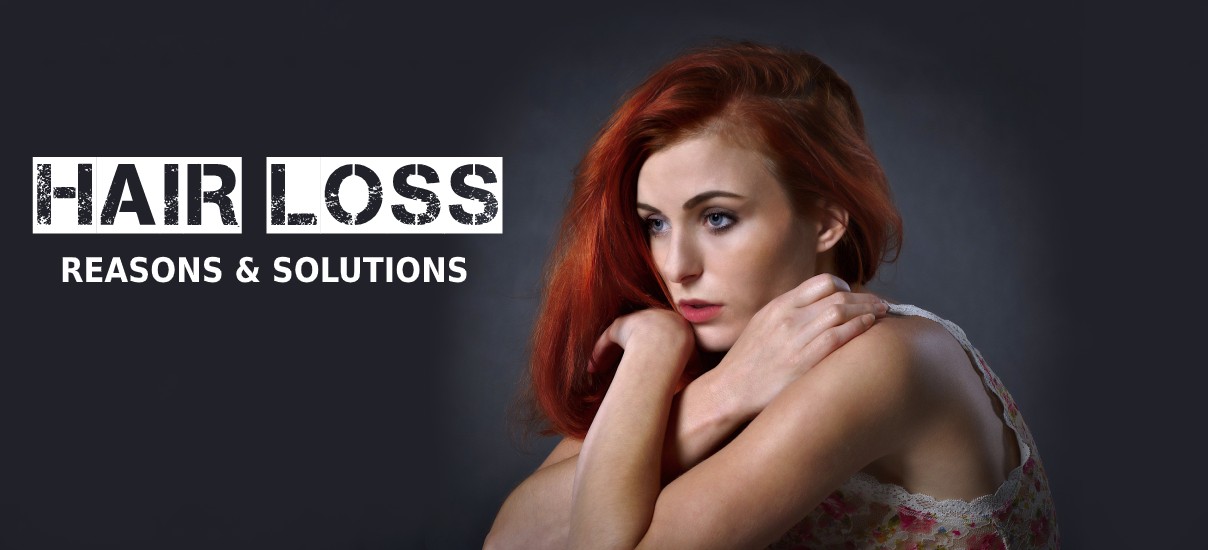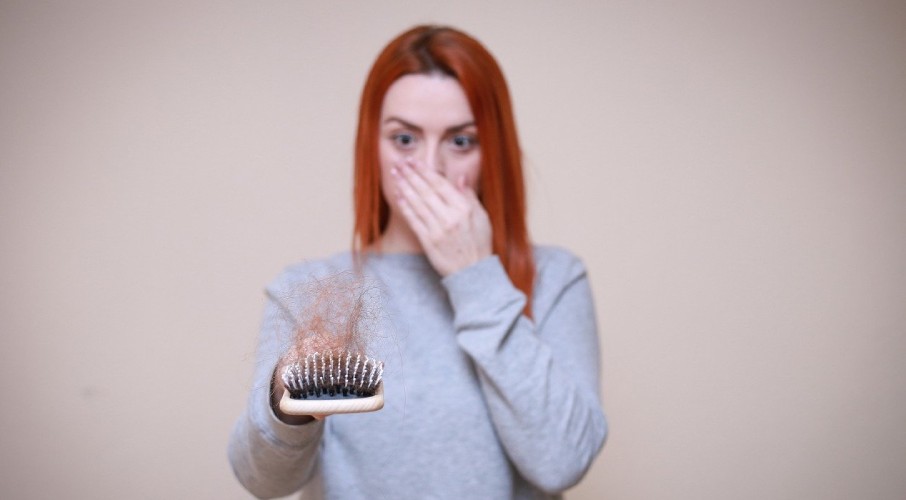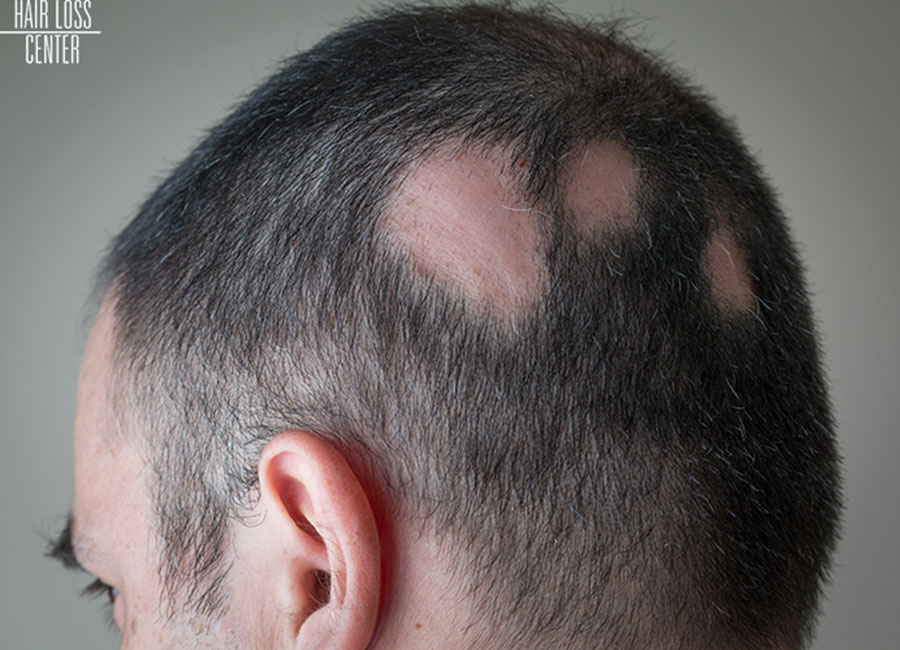

What Causes Hair Loss in Women and Men, and How to Prevent It?
Excessive hair shedding can happen at all ages in both men and women. However, to prevent hair loss in women and men from advancing and find the best solution to it, you have to first find out its cause(s).
In this article, we’ll go over the most common causes of hair loss in men and women. After you get familiar with the reasons, it’ll be easier for you to take some preventative measures and/or choose the most suitable solution for that certain type of hair loss.
At the end, we’ll also discuss hair loss prevention and answer some of your most common questions regarding hair loss treatments.
Looking for a risk-free and easy solution to hair loss? Here are the best quality human hair wigs in Southern California for any type of hair loss.
Call our Hair Loss Centers in Los Angeles, San Diego, and Orange for more information.
Hair Loss in Women; Causes, Solutions, and Prevention

Hair loss in women is only about 10 to 15% lower than the number of men experiencing hair loss. Shocking but true! Statistics show that 4 out of 10 women by the age of 50 have already experienced a kind of female pattern baldness, or excessive hair shedding. Some can be temporary, while others are chronic.
The first thing to do when you see you are losing more than 100 strands of hair a day is to find out what is the root cause of this sudden increase because everything else, like the best hair loss treatment and solutions, depends on why it is happening.
Here are the most common causes of hair loss in women, what’s the best solution for each, and what you can do to prevent it.
Genetic Hair Loss
When it comes to our genes, they can play a big role in causing female pattern hair loss (FPHL), also called androgenetic alopecia. This female baldness happens due to follicles’ sensitivity to the hormone DHT (dihydrotestosterone) and can start at any age after puberty.
This is a condition we inherit from our parents and can pass it down to the next generation. The DHT makes our hair follicles weak and eventually, they stop growing new hair. This results in a diffuse hair thinning at the crown and top of our head.
Prevention and Best Solutions/Treatments
As we get older, androgenetic alopecia advances. Although it is a genetic condition, we may be able to slow down the progress and its severity by taking some medications, like Minoxidil, managing stress, including necessary nutrition for hair growth in our diet, using suitable hair care products, and being gentle with our hair. Above all, seeking medical advice from a professional at an early stage can go a long way.
However, if it is advanced, the best hair loss solutions and treatments for this type of alopecia for women include
- Hair toppers for women: These hair pieces for women only cover the top and crown parts of the head and can blend in well with the rest of your own hair for a super natural look. Especially, if you opt for real hair toppers with the right color and texture that go with your natural hair.
- Monofilament wigs: The monofilament cap in this kind of wigs looks exactly like your scalp. This gives it a very realistic look. That’s why monofilament wigs are one of the best solutions for androgenetic alopecia. (Read this guide on Tips to Buy a Wig)
- Low-level laser therapy: To reduce the DHT and increase the blood flow, sometimes low-level laser therapy (LLLT) is recommended. It is a non-invasive method that can stimulate the follicles to grow again.
- Female hair implant: This is usually the last resort for women with severe genetic hair loss.
To learn more about different hair treatment for hair loss in women and some home remedies read ‘Female Pattern Baldness: Types, Treatments, Home Remedies’.
Hormonal Imbalance and Hair Shedding
Except for the sensitivity of follicles to DHT, which mostly has its roots in genetics, other hormonal factors can also lead to hair loss in women. A hormonal imbalance in women that causes hair thinning and shedding can be the result of the following conditions:
- Menopause (estrogen and progesterone levels decrease),
- Polycystic ovary syndrome or PCOS (the levels of testosterone and other androgens increase),
- Hypothyroidism and hyperthyroidism,
- Pregnancy,
- Childbirth (postpartum hair shedding),
- Medications (like birth control, hormone therapy, etc.),
- Adrenal gland disorders (cortisol imbalance).
It’s necessary to find what is triggering hormone hair loss and try medications to regulate hormone levels and maintain the balance. The good news is that, in most cases, hormonal hair loss is temporary or can be managed by retaining the hormonal balance. However, you should try to address the issue in the early stages before hair loss advances.
Besides, managing stress, having a good diet, taking care of your scalp and hair properly, protecting your hair from harsh conditions and environmental factors, using appropriate hair care products for your condition, and regular check-ups can play a significant role in reducing hair thinning as a result of hormonal imbalances.
Best Treatments and Solutions to Hormone Hair Loss
- Hormone therapy, to eliminate the underlying cause of hormonal imbalances and regulate the hormone levels in women.
- Topical medication, like Minoxidil.
- Platelet-rich plasma (PRP), during which the patient’s plasma is injected into their scalp to stimulate the hair follicles.
- LLLT,
- Supplements that contain the essential nutrients for healthy hair and hair growth (biotin and other B vitamins, vitamins C and D, zinc, iron, omega-3, etc.),
- Scalp massage, scalp serum, and other scalp treatments,
- Custom wigs and lace front human hair wigs create an impeccable hairline and look very natural. It’s also possible to have a wig made from your own hair for an optimum realistic look.
Aging
You may have noticed that as women get older the density and thickness of their hair reduce little by little. This happens because
- less follicles are being produced,
- the hair shaft gets thinner and thinner,
- and the scalp does not produce enough oil to protect the hair.
Now, if there are any other causes for hair loss as well, such as genetic disposition, aging can worsen the condition.
To prevent or reduce hair shedding due to aging, women should
- ensure they follow a balanced diet that provides all the essential nutrients needed for healthy hair,
- adopt a healthier lifestyle manage stress,
- protect their hair against too much hairstyling, harsh chemicals, and environmental factors,
- follow a good haircare routine,
- consult with a dermatologist for the best hair loss treatments for their specific condition.
Except for medication, PRP therapy, LLLT, and human hair glueless wigs and hair pieces are some other solutions for aging hair loss in women.
Medical Conditions, Medications and Treatments
Some medical conditions and/or their treatments can lead to hair loss in women. These include
- Hormonal disorders: Polycystic ovary syndrome, hypothyroidism, hyperthyroidism,
- Alopecia: Androgenetic alopecia (female pattern baldness) and alopecia areata (an autoimmune condition that causes patchy hair loss),
- Side effects of medications and treatments: Chemotherapy (like cancer patients), blood thinners, antidepressants, autoimmune conditions medications, etc.,
- Telogen effluvium (a temporary hair loss triggered by stress, hormonal changes, illness, etc.),
- Lupus (another autoimmune condition that results in patchy hair loss),
- Nutritional deficiencies: Anemia (lack of iron), inadequate intake of vitamins B and D, proteins, zinc, and other essential minerals,
- Scalp infection: Ringworm, lice, dandruff,
- Psychological disorders: Trichotillomania (the urge to pull out your own hair), severe and chronic anxiety, and depression.
As we have discussed above, seeking professional help ASAP to treat the condition can prevent further hair loss. During this time, one of the best solutions is wearing medical wigs (aka cranial prosthesis) to maintain your privacy and boost your spirit. Besides, usually, the scalp is sensitive in these patients and wigs can protect their scalp against natural elements.
We specialize in hair loss. That is why, for each type of medical condition we have a special kind of wig. See our medical wigs and call our Hair Loss Centers to consult with one of our wig experts.
Free ConsultationLifestyle and Environmental Factors
Except for the above-mentioned physiological causes for hair loss in women, some lifestyle and environmental factors affect healthy hair growth and/or increase hair shedding.
- Smoking and addiction to any kind of drugs,
- Sleep deprivation,
- Damaging hairstyling practices and harsh chemicals,
- Unsuitable haircare products,
- Unhealthy diet,
- Lack of scalp hygiene,
- Prolonged exposure to UV,
- Air pollution,
- Washing the hair with hard water,
- Extreme temperatures,
- Chlorinated water (like pool water),
- Saltwater (sea water).
To avoid hair shedding as a result of these factors, you can
- use protective hair products (for example for heat styling),
- wear a head scarf or a hat to protect your scalp and hair from pollution and extreme weather,
- wash your hair immediately after swimming,
- keep your hair and scalp hydrated,
- and follow a good haircare routine, a balanced diet, and a healthier lifestyle.
What Causes Male Pattern Baldness? What Are the Best Solutions?
While some causes of hair loss in women and men are the same, such as lifestyle factors, medication side effects, and medical conditions (read the previous section for a full discussion), others are a bit different.
Androgenetic Alopecia in Men
While both men and women may suffer from this type of genetic and hormonal hair loss, for men the sensitivity of hair follicles to the hormone DHT causes not only hair thinning and hair loss at the top and crown parts of the scalp but also receding hair line. This is called male pattern baldness.
If the condition advances, it will result in a horseshoe-shaped pattern. It is when you only have hair on the sides and back of the head.
In this case, the best hair loss treatment for men is either a hair transplant or wearing human hair toupees. Both of these hair loss solutions are very popular among men and each comes with its own benefits and drawbacks.
For example, hair transplant for men is a permanent solution in many cases, but it is a costly and invasive method. On the contrary, men’s wigs and toupees offer a risk-free and instant solution but it isn’t permanent. To learn more, read our objective comparison between ‘Hair Transplant or Hair Systems?’.
Other Types of Alopecia in Men
Except for androgenetic alopecia, other types of alopecia can also be the cause of your hair loss.
- Alopecia Areata: As in women, alopecia areata can cause patchy baldness in men.
- Alopecia Totalis: When alopecia areata advances and covers the whole scalp, it is called alopecia totalis. This condition causes complete hair loss.
- Scarring Alopecia: Some inflammatory conditions (like some infections, discoid lupus erythematosus (DLE), folliculitis decalvans, etc.) can destroy the follicles permanently resulting in hair loss and scarring.
Like androgenetic alopecia, the best hair loss solutions for these types of male hair loss are hair transplants or hair replacement systems.

Telogen Effluvium in Men
When the natural cycle of hair growth is disrupted, you will experience extensive hair shedding. However, telogen effluvium is mostly temporary. To prevent it, you should avoid
- chronic stress,
- rapid weight loss or other physical stress,
- nutritional deficiencies,
- and hormonal imbalance.
Sometimes, damaging hairstyling habits, such as cornrows, can put a lot of tension on the follicles and permanently damage them. This is also called traction alopecia. Change your hairstyle often to avoid placing prolonged tension on follicles in certain areas. (Check out a few of our human hair wigs for men here.)
Hair Loss Treatment FAQs
Let’s go over a few of your common concerns and questions about hair loss cure and solutions in men and women.
How Can I Identify the Underlying Cause of My Hair Loss?
To find out what is causing your hair loss, you should consult with a dermatologist. You may be asked to take some blood and hormone tests to see if there is any medical condition causing the problem. Additionally, they usually examine your scalp to check the conditions of the follicles and scalp and may recommend a scalp biopsy. You should also be prepared to answer questions about your lifestyle, hair care routine, diet, etc.
After all these examinations, the dermatologist can figure out what is causing your hair loss and recommend medications and other treatments.
Can I Prevent My Hair Loss?
The answer depends on the type of hair loss. If it is androgenetic alopecia, it is usually unavoidable but can be controlled to some extent. Other types of hair loss usually stop when the underlying cause is eliminated, like hormonal imbalance and telogen effluvium.
Should I Cover My Baldness?
It’s totally up to you. Make your decision based on your own feelings and preferences. Whatever makes you feel more comfortable and confident seems like the best choice.
Where Is a Good Place to Test Wigs and Hair Systems in Southern California?
Newport Hair Loss Center is proud to help and support individuals suffering from different types of hair loss in different ways. You can call our offices in Los Angeles (310-991-0087), San Diego (949-640-4247), and Orange (949-322-9555) to schedule a 30-minute free consultation session with one of our experienced experts.
LA OFFICE
Beverly Hills
8383 Wilshire Blvd, First Floor
Los Angeles, CA 90211
ORANGE COUNTY OFFICE
NEWPORT BEACH
240 Newport Center Drive, Suite 111
Newport Beach, CA 92660
SAN DIEGO OFFICE
LA JOLLA
4660 La Jolla Village Dr. Suite100
San Diego, CA 92122
NEWPORT HAIR LOSS CENTER
Newport Hair Loss Center gives hair loss sufferers a way to restore their appearance and boost their confidence, whether they are suffering from trichotillomania, alopecia, or are currently going through chemotherapy.
Site Map

